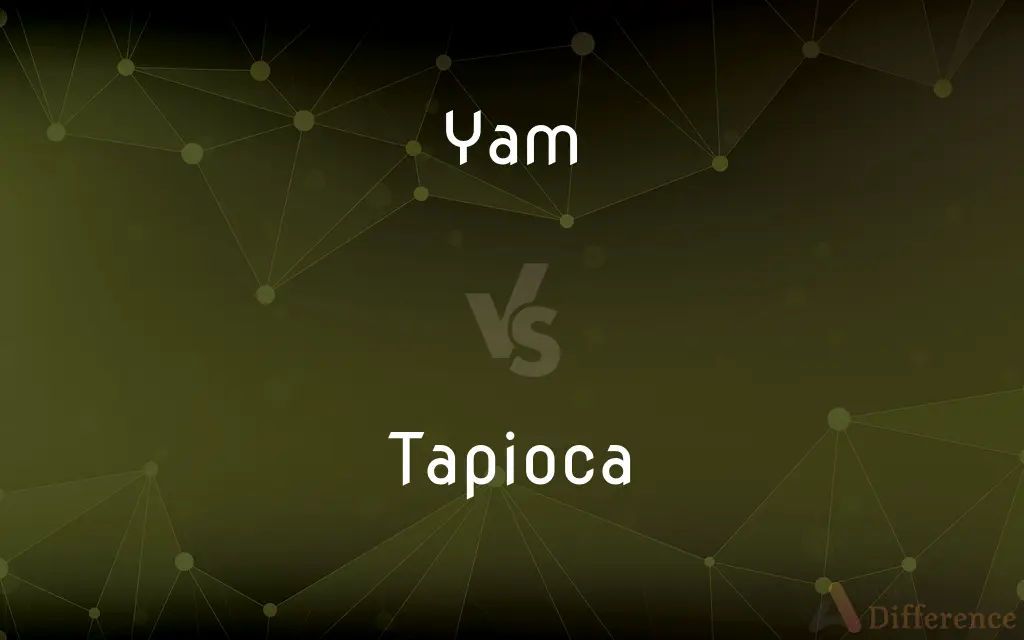Yam vs. Tapioca — What's the Difference?
By Tayyaba Rehman — Updated on December 25, 2023
Yam is a starchy tuberous root, while tapioca is a starch extracted from cassava roots.

Difference Between Yam and Tapioca
Table of Contents
ADVERTISEMENT
Key Differences
Yam, a tuberous root vegetable, is known for its rough skin and variable size, typically consumed as a whole food. Tapioca, on the other hand, is a processed starch product extracted from the roots of the cassava plant, often used as a thickening agent.
Nutritionally, yam offers dietary fiber, vitamins, and minerals, serving as a substantial food source in many cultures. Tapioca primarily provides carbohydrates, with minimal protein, fiber, or nutrients, and is often used in puddings and as a gluten-free flour alternative.
The culinary applications of yam are diverse, ranging from boiling, baking, to frying, appreciated for its texture and flavor. Tapioca, in contrast, is prized for its thickening properties in soups, sauces, and baking, and for its unique texture in tapioca pearls.
In terms of cultivation, yam is grown in a variety of species and climates, primarily in Africa, Asia, and Latin America. Tapioca, derived from cassava, is predominantly cultivated in South America and Africa, requiring processing to remove natural toxins.
Yam, with its cultural significance, features in many traditional dishes, symbolizing abundance in some cultures. Tapioca, although less significant culturally, has gained global popularity, especially in bubble tea and gluten-free products.
ADVERTISEMENT
Comparison Chart
Form
Tubular root vegetable
Starch extracted from cassava root
Nutrition
Rich in fiber, vitamins, minerals
High in carbs, low in protein/fiber
Use
Consumed as a food source
Used as a thickener, in puddings
Cultivation
Grown globally, many species
Derived from cassava, processed
Cultural Role
Important in traditional cuisines
Popular in modern, diverse cuisines
Compare with Definitions
Yam
Yam is a nutritious, starchy root vegetable.
I love the sweet taste of baked yam in winter.
Tapioca
Tapioca serves as a gluten-free thickening agent.
She used tapioca instead of flour to thicken the sauce.
Yam
Yam refers to a tuber grown in tropical regions.
Yams are a staple in many African diets.
Tapioca
Tapioca is a starch extracted from cassava roots.
Tapioca pearls are essential in bubble tea.
Yam
Yam, a versatile food, can be cooked in various ways.
We made a delicious yam curry for dinner.
Tapioca
Tapioca is known for its chewy texture in food.
Tapioca adds a unique texture to this dessert.
Yam
Yam, distinct from sweet potatoes, has a rough skin.
Yam and sweet potatoes look similar but taste different.
Tapioca
Tapioca is a versatile ingredient in various cuisines.
We experimented with tapioca in our vegan recipes.
Yam
Yam is known for its high carbohydrate content.
Athletes often eat yam for energy.
Tapioca
Tapioca is popular in puddings and desserts.
My grandmother's tapioca pudding is the best.
Yam
Any of numerous chiefly tropical vines of the genus Dioscorea, many of which have edible tuberous roots.
Tapioca
Tapioca (; Portuguese: [tapiˈɔkɐ]) is a starch extracted from the storage roots of the cassava plant (Manihot esculenta, also known as manioc), a species native to the north and central-west regions of Brazil, but whose use is now spread throughout South America. The plant was brought by the Portuguese to much of West Indies, Africa and Asia.
Yam
The starchy root of any of these plants, used in the tropics as food.
Tapioca
A starch made from cassava roots, usually processed as beads or flakes and used for puddings and as a thickening agent in cooking.
Yam
See sweet potato.
Tapioca
A dish, especially a pudding, made from this starch.
Yam
Any climbing vine of the genus Dioscorea in the Eastern and Western hemispheres, usually cultivated.
Tapioca
A starchy food made from the cassava plant, used in puddings.
Yam
The edible, starchy, tuberous root of that plant, a tropical staple food.
Tapioca
The cassava plant, Manihot esculenta, from which tapioca is derived; manioc.
Yam
(US) A sweet potato; a tuber from the species Ipomoea batatas.
Tapioca
A coarsely granular substance obtained by heating, and thus partly changing, the moistened starch obtained from the roots of the cassava. It is much used in puddings and as a thickening for soups. See Cassava.
Yam
(Scotland) Potato.
Tapioca
Granular preparation of cassava starch used to thicken especially puddings
Yam
(NZ) A oca; a tuber from the species Oxalis tuberosa.
Yam
Taro.
Yam
An orange-brown colour, like the flesh of the yam. en
Yam
A large, esculent, farinaceous tuber of various climbing plants of the genus Dioscorea; also, the plants themselves. Mostly natives of warm climates. The plants have netted-veined, petioled leaves, and pods with three broad wings. The commonest species is Dioscorea sativa, but several others are cultivated.
Yam
Any one of several cultural varieties of the sweet potato.
Yam
Edible tuber of any of several yams
Yam
Any of a number of tropical vines of the genus Dioscorea many having edible tuberous roots
Yam
Sweet potato with deep orange flesh that remains moist when baked
Yam
Edible tuberous root of various yam plants of the genus Dioscorea grown in the tropics world-wide for food
Common Curiosities
Can yam be eaten raw?
It's not recommended to eat yam raw due to potential toxins; cooking is advised.
What is tapioca?
Tapioca is a starch extracted from cassava roots, used in cooking and baking.
What is yam?
Yam is a starchy tuberous root, commonly consumed in various parts of the world.
Is tapioca gluten-free?
Yes, tapioca is naturally gluten-free, making it suitable for gluten-sensitive diets.
What are tapioca pearls?
Tapioca pearls are small, chewy balls made from tapioca, often used in bubble tea.
How is yam different from sweet potatoes?
Yam is typically larger, starchier, and has rougher skin compared to sweet potatoes.
Is tapioca healthy?
Tapioca is low in nutrients but can be part of a balanced diet in moderation.
What dishes are yams used in?
Yams are used in a variety of dishes, from soups and stews to baked goods.
Does tapioca have any protein?
Tapioca has very little protein and is mostly carbohydrate.
Can tapioca be used as a flour substitute?
Yes, tapioca can be used as a flour substitute, especially for thickening.
Are yams only grown in Africa?
No, yams are grown in many tropical regions, including Asia and the Americas.
Is yam high in carbohydrates?
Yes, yam is high in carbohydrates and provides energy.
Are yams and tapioca interchangeable in recipes?
No, they serve different purposes and are not typically interchangeable.
How is tapioca processed?
Tapioca is processed by grinding cassava roots and extracting the starch.
Can yam be used in desserts?
Yes, yam can be used in desserts, especially in sweet preparations.
Share Your Discovery

Previous Comparison
Corrido vs. Ranchera
Next Comparison
Rinse vs. SoakAuthor Spotlight
Written by
Tayyaba RehmanTayyaba Rehman is a distinguished writer, currently serving as a primary contributor to askdifference.com. As a researcher in semantics and etymology, Tayyaba's passion for the complexity of languages and their distinctions has found a perfect home on the platform. Tayyaba delves into the intricacies of language, distinguishing between commonly confused words and phrases, thereby providing clarity for readers worldwide.












































